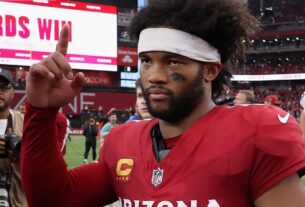The NCAA’s new name, image and likeness transparency platform, NIL Assist, went live on Thursday morning, providing deidentified NIL compensation information, as well as a service provider registry and educational programming.
The app and website, created in conjunction with Teamworks, creates for the first time a public database-like platform where athletes and the public can find the average and median earnings for NIL deals, sortable by subdivision, sport, position and type of NIL transaction. It aims to show, for example, what a Power 4 quarterback makes on average for a social media post — on Thursday morning, the website’s data dashboard reported that the average disclosure under those parameters was $6,605 but that the median was $150.
Here’s an example from the NIL dashboard, which says the average social media NIL deal for a P4 QB is $6,605, but the median is $150.
(The NCAA emphasized the data will get more accurate as time goes on and more info comes in). https://t.co/NmGUrSmzXD pic.twitter.com/LvIM3KikpT
— Chris Vannini (@ChrisVannini) August 1, 2024
In January, the Division I Council adopted new rules requiring athletes to disclose to their schools any NIL agreement exceeding $600, including terms of the deal, services rendered and payment. The schools then must share the information, stripped of names, to the NCAA at least twice per year. More than 20 states already require similar disclosures.
“We’ve heard from coaches, student-athletes, their families, they want some information about what the market is yielding, and we think if we do it publicly, that’s the best way to do it,” NCAA vice president of academic and membership affairs David Schnase said. “There are going to be some who want way more information than this is going to provide, but at least this is a starting point for folks who are trying to figure that out.”
Although athletes are required to disclose their NIL deals, there isn’t a clear penalty yet for not doing so. NCAA officials emphasized that this database won’t be used as an eligibility trap and is just for information. The Division I Council in April added an incentive, allowing schools to provide more NIL assistance to athletes who disclose their NIL deals.
“That student-athlete can choose not to disclose, but they then can’t take advantage of institutional assistance as it relates to NIL, so we think there’s a bit of a carrot,” Schnase said.

Free, daily sports updates direct to your inbox.
Free, daily sports updates direct to your inbox.
Officials cautioned that the data isn’t complete at launch but will improve with time as more information is put into the system. They also acknowledged concerns of conflict of interest with Teamworks, which itself has an NIL management service.
“We’re treating this partnership as an individual endeavor,” Teamworks senior vice president of business development Kevin Barefoot said. “We’re not taking any data from this project and using it in other commercial forms. This is a project partnering with the NCAA that narrowly focused on delivering to schools and student-athletes what they requested and voted on with NCAA bylaws.”
In addition to NIL data, the NIL Assist platform has a voluntary service provider registry for agents, brands, collectives and products. Officials hope providers will sign up, allowing athletes to find more connections or to review previous work, which could help other athletes in the future find an agent.
When The Athletic surveyed agents and collectives earlier this summer and asked about the registry, several said they wouldn’t sign up and questioned its value or impact.
“It’s been mixed, which is what we expected,” Barefoot said of the registry sign-ups. “Some people have said they feel good about the access and visibility among student-athletes. … Perfect is the enemy of good here. If we can get to a point where there’s more information out for student-athletes to understand the market and the service providers, that’s a great outcome.”

GO DEEPER
What’s the future of NIL collectives after the House v. NCAA settlement?
The disclosure of NIL data could play a role in the recent House settlement proposal, which spells out the idea of a clearinghouse to vet contracts and includes the potential creation of an enforcement arm to determine the fair market value of NIL deals and whether they’re true NIL arrangements. Collectives have already questioned the legality of that practice, and it’s not clear how that would play out if the settlement is approved.
“There are a lot of things happening outside of what we can control with this platform,” Schnase said. “So while this platform will not influence those outcomes, when the board starts making decisions, we’ll have pretty good data to help them make informed decisions. That’s the most important part of this looking forward. … I wouldn’t specify the (House settlement), but there’s active litigation that’s influencing a lot of our decisions right now.”
(Photo: Jacob Kupferman / Getty Images)





